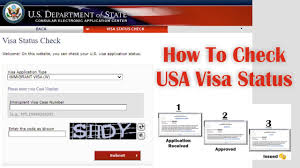Understanding US Visa Status Enquiry

The process of obtaining a US visa can be both exciting and nerve-wracking. Whether you are a student planning to study in the United States, a professional seeking employment, or a tourist eager to explore American landmarks, “knowing your visa status” is crucial. This article aims to provide a comprehensive guide on US VISA STATUS ENQUIRY, covering various aspects such as the types of visas, the application process, how to check your visa status, and what steps to take if you encounter issues.
Types of US Visas
Understanding the different types of US visas is the first step in the visa status enquiry process. The US offers a wide range of visas categorized into immigrant and non-immigrant visas.
- Non-Immigrant Visas Non-immigrant visas are for temporary stays in the US. They include:
- B-1/B-2 Visas: For business and tourism.
- F-1 and M-1 Visas: For students.
- H-1B Visa: For specialized workers.
- L-1 Visa: For intra-company transferees.
- J-1 Visa: For exchange visitors.
- O-1 Visa: For individuals with extraordinary abilities.
- Immigrant Visas Immigrant visas are for those who wish to live permanently in the US. These include:
- Family-Sponsored Visas: For family members of US citizens and permanent residents.
- Employment-Based Visas: For workers with specific skills.
- Diversity Visa Lottery: For nationals of countries with low immigration rates to the US.
The Visa Application Process
The visa application process involves several steps that must be followed meticulously to avoid delays or denials.
- Determine the Appropriate Visa Determine the visa category that fits your purpose of travel.
- Complete the DS-160 Form The DS-160 form is the online non-immigrant visa application. It requires personal details, travel plans, and other relevant information. Ensure that all information is accurate and consistent.
- Pay the Visa Fee The visa fee varies depending on the type of visa. Payment can usually be made online, and it is essential to keep the receipt as proof of payment.
- Schedule a Visa Interview Schedule an appointment for a visa interview at the nearest US embassy or consulate. For some visa types, such as H-1B, this step might involve additional steps like submitting a petition.
- Attend the Visa Interview Attend the interview with all required documents, including your passport, DS-160 confirmation page, visa fee payment receipt, and any other supporting documents specific to your visa category. US VISA REQUIREMENTS
Checking Your Visa Status
Once you have attended your visa interview, the waiting period begins. During this time, you can check your visa status online. Here’s how:
- Visit the CEAC Website The Consular Electronic Application Center (CEAC) is the official portal for checking your visa status. Navigate to the CEAC website.
- Enter Your Application Details You will need your DS-160 confirmation number and the location where you applied for the visa.
- Check Your Status The CEAC portal will display the current status of your visa application. Common status messages include:
- Application Received: Your application has been received but not yet processed.
- Administrative Processing: Additional review is required.
- Issued: Your visa has been approved.
- Refused: Your visa application has been denied.
Understanding Visa Status Messages
Interpreting the visa status messages is essential to know where you stand in the application process.
- Application Received This status indicates that your application has been received by the consulate or embassy but has not yet been reviewed.
- Administrative Processing Administrative processing means your application requires further review. This can happen for various reasons, such as additional security checks or the need for more documentation. This process can take several weeks to months.
- Issued If your status shows “issued,” congratulations! Your visa has been approved, and you can expect to receive it shortly.
- Refused A refusal means your application did not meet the requirements. The consulate will provide a reason for the refusal, and you may be eligible to reapply or appeal the decision.
Common Reasons for Visa Delays and Denials
Several factors can lead to delays or denials in the visa application process. Understanding these can help you avoid common pitfalls.
- Incomplete or Inaccurate Application Any discrepancies or missing information in your application can result in delays or denial.
- Insufficient Documentation Failing to provide all required documents, such as proof of financial support or ties to your home country, can cause issues.
- Background Checks Certain applicants may undergo additional security checks, which can prolong the process.
- Previous Visa Issues If you have previously overstayed a visa or violated US immigration laws, your application may be subject to additional scrutiny.
What to Do If Your Visa is Delayed or Denied
Receiving a delay or denial can be disheartening, but there are steps you can take to address the situation.
- For Delays
- Be Patient: Administrative processing can take time. Regularly check your status online.
- Contact the Consulate: If your application has been in administrative processing for an extended period, contact the consulate for updates.
- For Denials
- Understand the Reason: Carefully review the reason for denial provided by the consulate.
- Reapply: Address the issues that led to the denial and reapply with a stronger application.
- Seek Legal Assistance: If you believe the denial was unjust, consider consulting an immigration attorney.
Resources and Support for Visa Applicants
Navigating the visa application process can be challenging, but numerous resources and support systems are available to help.
- US Department of State Website The official website provides detailed information on visa types, the application process, and status enquiries.
- Embassy and Consulate Websites Each US embassy and consulate has a website with specific information and contact details for visa applicants.
- Immigration Attorneys Hiring an immigration attorney can provide personalized guidance and support, especially for complex cases.
- Online Forums and Communities Various online forums and social media groups offer a platform for visa applicants to share experiences and advice.
Tips for a Successful Visa Application
To increase your chances of a successful visa application, consider the following tips:
- Prepare Thoroughly Gather all necessary documents and ensure they are accurate and up-to-date.
- Be Honest Provide truthful and consistent information throughout your application and interview.
- Show Strong Ties to Your Home Country Demonstrate that you have compelling reasons to return to your home country after your US visit.
- Practice for the Interview Prepare for common interview questions and practice your responses to convey confidence and clarity.
Conclusion
Enquiring about your US visa status is a crucial step in the visa application process. By understanding the different types of visas, following the correct application procedures, and knowing how to check and interpret your visa status, you can navigate the process with greater ease and confidence. Remember, while delays and denials can be challenging, resources and support are available to help you overcome these hurdles. With thorough preparation and a clear understanding of the process, you can improve your chances of obtaining the visa you need to achieve your travel, study, or work goals in the United States.
